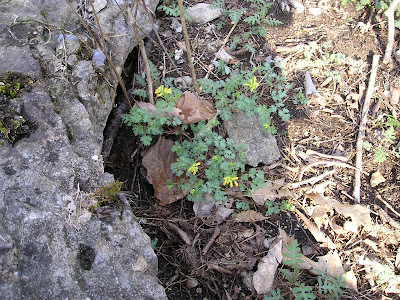On Saturday we went up to visit the in-laws for Easter. The day was cool but sunny with a little wind and with the right amount of layering was quite pleasant. It was one of those spring days that almost, just almost felt like spring. It still had the cool sentiments of our Tennessee winters. After visiting for a little while and having lunch, I went exploring the woods in the back. They have about 6 acres of land around their house, most of which is natural woodlands. I don't get back there often enough but each time I do I try to find something new to look at. Saturday was a good day for that! I was fortunate to find this little flower, and I mean little! The flowers are probably less than half an inch in length.

I didn't know what it was at first, but I found it interesting and took several pictures. I even collected two of them to bring into my garden. I took care to leave plenty of them there since I did not want to significantly disturb the natural habitat. The two I collected were in the mowing area of the yard so by collecting them I may have been saving them from the blades of the mower.
After we arrived home last evening I took out our Wildflowers of Tennessee book by Jack B. Carman and identified it as a Yellow Corydalis (Corydalis flavula). I was fascinated by the crested flowers and the feathery, almost fern like leaves. According to Jack Carman the Yellow Corydalis is an annual that appears in much of Tennessee and the northeastern U.S. in moist locations. They grow anywhere between four and twelve inches tall. Here's another interesting tidbit of information thanks to Mr. Carman: the genus name (Corydalis) comes from Greek and means crested lark. A very appropriate name to describe the flowers of this little wildflower.

The corydalis I found was thriving in the yard and back in the woods. It is probably one of those flowers that uses the shelter of the forest in the hot summer months and takes advantage of the the winter and early spring sun that streams in from the deciduous forest. Since it is an annual I hope to gather seed from the two transplants I collected. If not it will be worth appreciating even for a short time. In the picture below you can see a corydalis resting beneath a rocky outcropping.

I had a couple other discoveries that I'll share with you soon. One of which I still need to identify!Labels: around the yard, wildflowers


